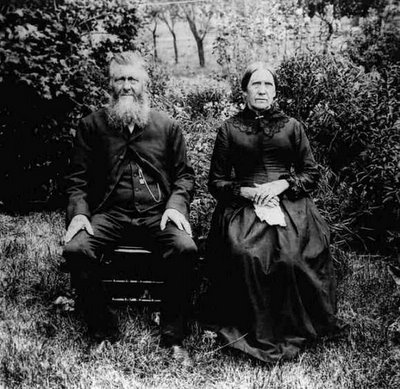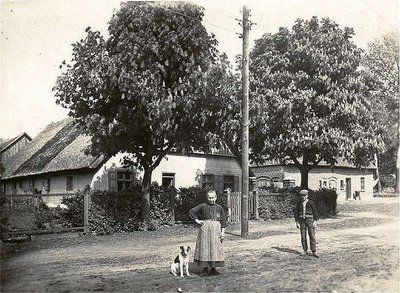Wednesday, January 11, 2006
In 1862, Friedrich and Frederike left their small village in Prussia and traveled to Hamburg, where they boarded the S. S. Robert Peel. No one knows why they left- perhaps they were seeking a better life, perhaps they were escaping high taxes or military conscription. Friedrich had been trained as a master tailor, going through an apprenticeship program. He would later work as a farmer and I doubt his tailoring skills ever saw much use.
On the long voyage across the ocean the couple's youngest child died and was buried at sea. The ship was supposedly blown off-course and ended up off South Carolina, a dangerous place to be during the Civil War. Eventually, the sailing ship arrived in New York City in June 1862, and the couple, their two children, and Frederike's parents and siblings traveled west to Erie County, New York, where they lived for a while before moving to Michigan.

Friedrich and Frederike.
These were my last ancestors to come from Europe. In 1998, I traveled back to their hometown, now a tiny community in Poland. At the end of World War II the Russians confiscated eastern Poland and moved all of the inhabitants to eastern Germany. Many of the Germans who lived in that tiny town were subsequently slaughtered, my cousin's grandmother had been sent to Bavaria towards the end of the war and escaped.
I wanted to see where my family had come from so I rented a car in Stettin and drove down country roads to the little town. Red brick houses and barns, usually joined together, were typical. The small church where my great-great-great-great grandparents were baptized as Lutherans had been converted into a Catholic Church after the war. Two women hoeing a potato field shouted questions at me in Polish when I stopped to take pictures. They were suspicious- at the time many people were worried in the area that people from Germany would be returning to reclaim their ancestral homes.
I could see why Friedrich and Frederika settled in central Michigan- the topography, climate, and vegetation were very similar to their home in Prussia. They would have felt comfortable their, surrounded by immigrant neighbors with similar backgrounds.
Some day I'd like to go back, this time with a translator so I could talk to the people who live there. I'd like to see if I could identify the family home, which is probably still standing. I guess I'll have to add that to the list of things I need to do.

Family members in Brusewitz.
Newer› ‹Older
On the long voyage across the ocean the couple's youngest child died and was buried at sea. The ship was supposedly blown off-course and ended up off South Carolina, a dangerous place to be during the Civil War. Eventually, the sailing ship arrived in New York City in June 1862, and the couple, their two children, and Frederike's parents and siblings traveled west to Erie County, New York, where they lived for a while before moving to Michigan.

Friedrich and Frederike.
These were my last ancestors to come from Europe. In 1998, I traveled back to their hometown, now a tiny community in Poland. At the end of World War II the Russians confiscated eastern Poland and moved all of the inhabitants to eastern Germany. Many of the Germans who lived in that tiny town were subsequently slaughtered, my cousin's grandmother had been sent to Bavaria towards the end of the war and escaped.
I wanted to see where my family had come from so I rented a car in Stettin and drove down country roads to the little town. Red brick houses and barns, usually joined together, were typical. The small church where my great-great-great-great grandparents were baptized as Lutherans had been converted into a Catholic Church after the war. Two women hoeing a potato field shouted questions at me in Polish when I stopped to take pictures. They were suspicious- at the time many people were worried in the area that people from Germany would be returning to reclaim their ancestral homes.
I could see why Friedrich and Frederika settled in central Michigan- the topography, climate, and vegetation were very similar to their home in Prussia. They would have felt comfortable their, surrounded by immigrant neighbors with similar backgrounds.
Some day I'd like to go back, this time with a translator so I could talk to the people who live there. I'd like to see if I could identify the family home, which is probably still standing. I guess I'll have to add that to the list of things I need to do.

Family members in Brusewitz.
